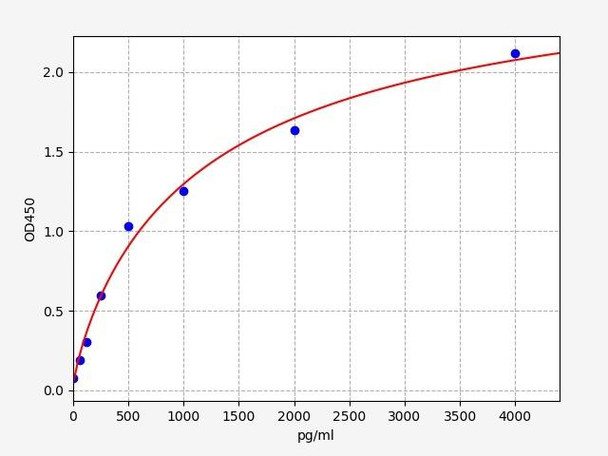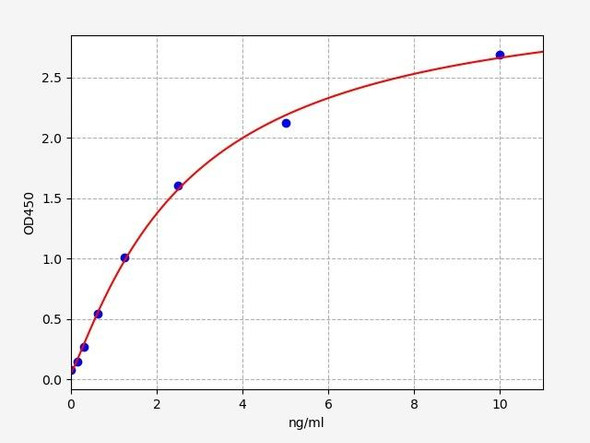Mouse E-Cadherin ELISA Kit (MOFI00032)
- SKU:
- MOFI00032
- Product Type:
- ELISA Kit
- Size:
- 96 Assays
- Uniprot:
- P09803
- Sensitivity:
- 37.5pg/ml
- Range:
- 62.5-4000pg/ml
- ELISA Type:
- Sandwich
- Synonyms:
- E-Cadherin, E-Cad, CDH1, Arc-1, CAD1, Cadherin-1, CD324, Cell-CAM120, ECAD, L-CAM, Uvomorulin, cadherin 1, E-cadherin, epithelial
- Reactivity:
- Mouse
Description
Mouse E-Cadherin ELISA Kit
The Mouse E-Cadherin ELISA Kit is specifically designed for the precise measurement of E-Cadherin levels in mouse serum, plasma, and cell culture supernatants. With its high sensitivity and specificity, this kit provides accurate and reproducible results, making it ideal for various research applications.E-Cadherin is a key protein involved in cell adhesion and plays a crucial role in maintaining tissue integrity and organization. Dysregulation of E-Cadherin has been linked to various diseases such as cancer and developmental disorders, highlighting its importance as a biomarker for studying these conditions and developing potential therapeutic interventions.
Overall, the Mouse E-Cadherin ELISA Kit offers researchers a reliable tool for quantifying E-Cadherin levels in mouse samples, facilitating a better understanding of its biological function and its implications in various diseases.
| Product Name: | Mouse E-Cadherin ELISA Kit |
| Product Code: | MOFI00032 |
| Size: | 96 Assays |
| Alias: | E-Cadherin, E-Cad, CDH1, Arc-1, CAD1, Cadherin-1, CD324, Cell-CAM120, ECAD, L-CAM, Uvomorulin, cadherin 1, E-cadherin, epithelial |
| Detection Method: | Sandwich ELISA |
| Application: | This immunoassay kit allows for the in vitro quantitative determination of Mouse E-Cad concentrations in serum plasma and other biological fluids. |
| Sensitivity: | 37.5pg/ml |
| Range: | 62.5-4000pg/ml |
| Storage: | 4°C for 6 months |
| Note: | For Research Use Only |
| Recovery: | Matrices listed below were spiked with certain level of Mouse E-Cad and the recovery rates were calculated by comparing the measured value to the expected amount of Mouse E-Cad in samples. | ||||||||||||||||
| |||||||||||||||||
| Linearity: | The linearity of the kit was assayed by testing samples spiked with appropriate concentration of Mouse E-Cad and their serial dilutions. The results were demonstrated by the percentage of calculated concentration to the expected. | ||||||||||||||||
| |||||||||||||||||
| Intra Assay: | CV <8% | ||||||||||||||||
| Inter Assay: | CV <10% |
| Component | Quantity | Storage |
| ELISA Microplate (Dismountable) | 8×12 strips | 4°C for 6 months |
| Lyophilized Standard | 2 | 4°C/-20°C |
| Sample/Standard Dilution Buffer | 20ml | 4°C |
| Biotin-labeled Antibody(Concentrated) | 120ul | 4°C (Protect from light) |
| Antibody Dilution Buffer | 10ml | 4°C |
| HRP-Streptavidin Conjugate(SABC) | 120ul | 4°C (Protect from light) |
| SABC Dilution Buffer | 10ml | 4°C |
| TMB Substrate | 10ml | 4°C (Protect from light) |
| Stop Solution | 10ml | 4°C |
| Wash Buffer(25X) | 30ml | 4°C |
| Plate Sealer | 5 | - |
Other materials and equipment required:
- Microplate reader with 450 nm wavelength filter
- Multichannel Pipette, Pipette, microcentrifuge tubes and disposable pipette tips
- Incubator
- Deionized or distilled water
- Absorbent paper
- Buffer resevoir
| Uniprot | P09803 |
| UniProt Protein Function: | CDH1: a single-pass type I membrane protein, and calcium dependent cell adhesion proteins. It is a ligand for integrin alpha-E/beta-7, and it colocalizes with DLG7 at sites of cell-cell contact in intestinal epithelial cells. Anchored to actin microfilaments through association with alpha-, beta- and gamma-catenin. Sequential proteolysis induced by apoptosis or calcium influx, results in translocation from sites of cell-cell contact to the cytoplasm. Involved in mechanisms regulating cell-cell adhesions, mobility and proliferation of epithelial cells. Defects in CDH1 are involved in dysfunction of the cell-cell adhesion system, triggering cancer invasion (gastric, breast, ovary, endometrium and thyroid) and metastasis. Has a potent invasive suppressor role. |
| UniProt Protein Details: | Protein type:Cell adhesion; Motility/polarity/chemotaxis; Membrane protein, integral; Ubiquitin ligase Cellular Component: apical junction complex; Golgi apparatus; internal side of plasma membrane; cell surface; focal adhesion; basolateral plasma membrane; lateral loop; integral to membrane; catenin complex; trans-Golgi network; intercellular junction; actin cytoskeleton; cell-cell adherens junction; adherens junction; membrane; apical part of cell; perinuclear region of cytoplasm; axon; cytoplasm; plasma membrane; nerve terminal; cell junction; endosome; lateral plasma membrane Molecular Function:protein domain specific binding; protein binding; gamma-catenin binding; metal ion binding; beta-catenin binding; GTPase activating protein binding; calcium ion binding; ankyrin binding; cell adhesion molecule binding; glycoprotein binding; protein phosphatase binding Biological Process: in utero embryonic development; positive regulation of transcription, DNA-dependent; regulation of caspase activity; regulation of epithelial cell proliferation; trophectodermal cell differentiation; regulation of water loss via skin; cell-cell adhesion; sensory perception of sound; regulation of protein localization; synaptogenesis; protein metabolic process; calcium-dependent cell-cell adhesion; positive regulation of transcription factor import into nucleus; negative regulation of cell-cell adhesion; cell adhesion; homophilic cell adhesion; protein homooligomerization; negative regulation of epithelial cell proliferation |
| UniProt Code: | P09803 |
| NCBI GenInfo Identifier: | 115419 |
| NCBI Gene ID: | 12550 |
| NCBI Accession: | P09803.1 |
| UniProt Secondary Accession: | P09803,Q61377, |
| UniProt Related Accession: | P09803 |
| Molecular Weight: | 884 |
| NCBI Full Name: | Cadherin-1 |
| NCBI Synonym Full Names: | cadherin 1 |
| NCBI Official Symbol: | Cdh1 |
| NCBI Official Synonym Symbols: | Um; UVO; Ecad; E-cad; L-CAM; AA960649 |
| NCBI Protein Information: | cadherin-1; ARC-1; E-cadherin; uvomorulin; epithelial cadherin |
| UniProt Protein Name: | Cadherin-1 |
| UniProt Synonym Protein Names: | ARC-1; Epithelial cadherin; E-cadherin; Uvomorulin; CD_antigen: CD324Cleaved into the following 3 chains:E-Cad/CTF1; E-Cad/CTF2; E-Cad/CTF3 |
| Protein Family: | Cadherin |
| UniProt Gene Name: | Cdh1 |
| UniProt Entry Name: | CADH1_MOUSE |
*Note: Protocols are specific to each batch/lot. For the correct instructions please follow the protocol included in your kit.
| Step | Procedure |
| 1. | Set standard, test sample and control (zero) wells on the pre-coated plate respectively, and then, record their positions. It is recommended to measure each standard and sample in duplicate. Wash plate 2 times before adding standard, sample and control (zero) wells! |
| 2. | Aliquot 0.1ml standard solutions into the standard wells. |
| 3. | Add 0.1 ml of Sample / Standard dilution buffer into the control (zero) well. |
| 4. | Add 0.1 ml of properly diluted sample (Human serum, plasma, tissue homogenates and other biological fluids.) into test sample wells. |
| 5. | Seal the plate with a cover and incubate at 37 °C for 90 min. |
| 6. | Remove the cover and discard the plate content, clap the plate on the absorbent filter papers or other absorbent material. Do NOT let the wells completely dry at any time. Wash plate X2. |
| 7. | Add 0.1 ml of Biotin- detection antibody working solution into the above wells (standard, test sample & zero wells). Add the solution at the bottom of each well without touching the side wall. |
| 8. | Seal the plate with a cover and incubate at 37°C for 60 min. |
| 9. | Remove the cover, and wash plate 3 times with Wash buffer. Let wash buffer rest in wells for 1 min between each wash. |
| 10. | Add 0.1 ml of SABC working solution into each well, cover the plate and incubate at 37°C for 30 min. |
| 11. | Remove the cover and wash plate 5 times with Wash buffer, and each time let the wash buffer stay in the wells for 1-2 min. |
| 12. | Add 90 µL of TMB substrate into each well, cover the plate and incubate at 37°C in dark within 10-20 min. (Note: This incubation time is for reference use only, the optimal time should be determined by end user.) And the shades of blue can be seen in the first 3-4 wells (with most concentrated standard solutions), the other wells show no obvious color. |
| 13. | Add 50 µL of Stop solution into each well and mix thoroughly. The color changes into yellow immediately. |
| 14. | Read the O.D. absorbance at 450 nm in a microplate reader immediately after adding the stop solution. |
When carrying out an ELISA assay it is important to prepare your samples in order to achieve the best possible results. Below we have a list of procedures for the preparation of samples for different sample types.
| Sample Type | Protocol |
| Serum: | If using serum separator tubes, allow samples to clot for 30 minutes at room temperature. Centrifuge for 10 minutes at 1,000x g. Collect the serum fraction and assay promptly or aliquot and store the samples at -80°C. Avoid multiple freeze-thaw cycles. If serum separator tubes are not being used, allow samples to clot overnight at 2-8°C. Centrifuge for 10 minutes at 1,000x g. Remove serum and assay promptly or aliquot and store the samples at -80°C. Avoid multiple freeze-thaw cycles. |
| Plasma: | Collect plasma using EDTA or heparin as an anticoagulant. Centrifuge samples at 4°C for 15 mins at 1000 × g within 30 mins of collection. Collect the plasma fraction and assay promptly or aliquot and store the samples at -80°C. Avoid multiple freeze-thaw cycles. Note: Over haemolysed samples are not suitable for use with this kit. |
| Urine & Cerebrospinal Fluid: | Collect the urine (mid-stream) in a sterile container, centrifuge for 20 mins at 2000-3000 rpm. Remove supernatant and assay immediately. If any precipitation is detected, repeat the centrifugation step. A similar protocol can be used for cerebrospinal fluid. |
| Cell culture supernatant: | Collect the cell culture media by pipette, followed by centrifugation at 4°C for 20 mins at 1500 rpm. Collect the clear supernatant and assay immediately. |
| Cell lysates: | Solubilize cells in lysis buffer and allow to sit on ice for 30 minutes. Centrifuge tubes at 14,000 x g for 5 minutes to remove insoluble material. Aliquot the supernatant into a new tube and discard the remaining whole cell extract. Quantify total protein concentration using a total protein assay. Assay immediately or aliquot and store at ≤ -20°C. |
| Tissue homogenates: | The preparation of tissue homogenates will vary depending upon tissue type. Rinse tissue with 1X PBS to remove excess blood & homogenize in 20ml of 1X PBS (including protease inhibitors) and store overnight at ≤ -20°C. Two freeze-thaw cycles are required to break the cell membranes. To further disrupt the cell membranes you can sonicate the samples. Centrifuge homogenates for 5 mins at 5000xg. Remove the supernatant and assay immediately or aliquot and store at -20°C or -80°C. |
| Tissue lysates: | Rinse tissue with PBS, cut into 1-2 mm pieces, and homogenize with a tissue homogenizer in PBS. Add an equal volume of RIPA buffer containing protease inhibitors and lyse tissues at room temperature for 30 minutes with gentle agitation. Centrifuge to remove debris. Quantify total protein concentration using a total protein assay. Assay immediately or aliquot and store at ≤ -20 °C. |
| Breast Milk: | Collect milk samples and centrifuge at 10,000 x g for 60 min at 4°C. Aliquot the supernatant and assay. For long term use, store samples at -80°C. Minimize freeze/thaw cycles. |






